Cochiti Female Figurine with 2 Children in Her Arms by Felipa Trujillo - C3688.68
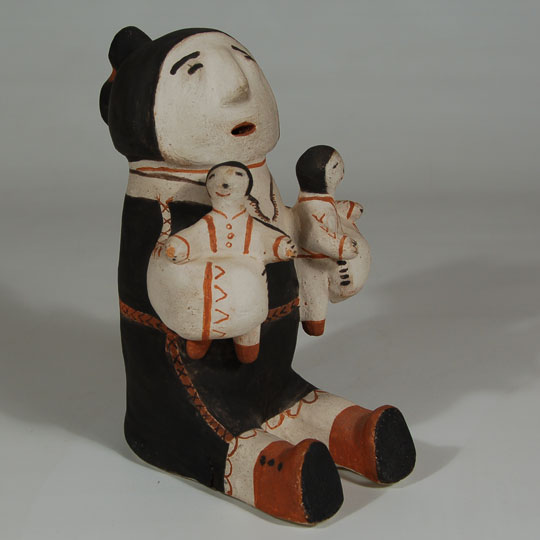 It is well known that Helen Cordero made what has now been named the Storyteller figurine in 1964. Her definition of a storyteller was that it was in honor of her grandfather, a well-known storyteller at Cochiti Pueblo, so it was always a male figurine in Helen's eyes.
It is well known that Helen Cordero made what has now been named the Storyteller figurine in 1964. Her definition of a storyteller was that it was in honor of her grandfather, a well-known storyteller at Cochiti Pueblo, so it was always a male figurine in Helen's eyes.
Before Helen Cordero's first storyteller, female figurines were made by potters at Cochiti and they have been named Singing Mothers. In the book The Pueblo Storyteller by Barbara Babcock, there is a Singing Mother figurine which Babcock says pre-dates 1930. She further states that "The shape of her head and ears and her 'coffee bean' eyes are remarkably similar to figures made by Felipa Trujillo in the 1960s and 1970s." If this is indeed one made by Felipa Trujillo before 1930, she must be one of the earliest Cochiti potters to do so.
Cochiti Pueblo Seated Male Storyteller with 2 Children by Carol Pecos - C3688.71
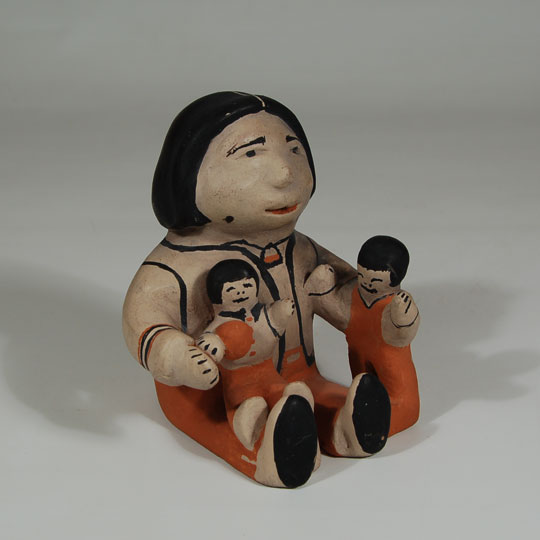 This seated male storyteller holds two young boys on his lap. The Cochti Pueblo potter is Carol M. Pecos but I have not yet determined who she is and what family she is from. She obviously is an accomplished potter as this figurine was beautifully constructed and painted. The adult's hair is sculpted around his face and his eyes are inset. It is quite a stunning figurine.
This seated male storyteller holds two young boys on his lap. The Cochti Pueblo potter is Carol M. Pecos but I have not yet determined who she is and what family she is from. She obviously is an accomplished potter as this figurine was beautifully constructed and painted. The adult's hair is sculpted around his face and his eyes are inset. It is quite a stunning figurine.
Cochiti Female Storyteller with 6 Children and 1 Dog by Mapuwana - C3688.72
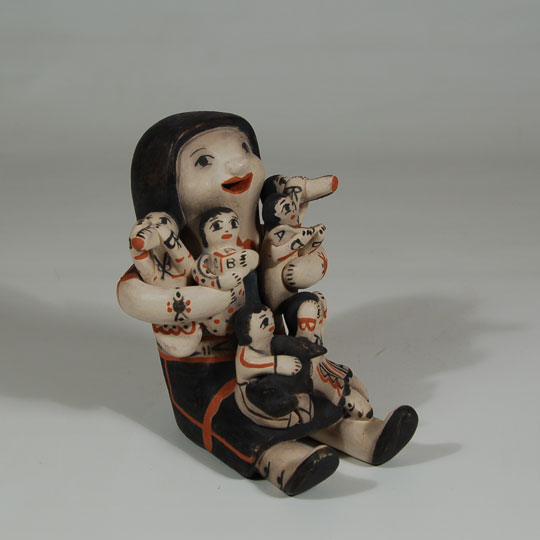 Cochiti Pueblo potter Juanita Inez Ortiz learned pottery making from her mother, Seferina, and her grandmother, Laurencita Herrera. It is traditional for pueblo potters to teach their children the art of pottery making starting at an early age. Inez's siblings, all of whom are potters, are Virgil, Joyce, and Janice. Inez was the mother of Lisa Holt. Unlike her brother, Virgil, Inez remained with traditional designs and shapes, much like her mother.
Cochiti Pueblo potter Juanita Inez Ortiz learned pottery making from her mother, Seferina, and her grandmother, Laurencita Herrera. It is traditional for pueblo potters to teach their children the art of pottery making starting at an early age. Inez's siblings, all of whom are potters, are Virgil, Joyce, and Janice. Inez was the mother of Lisa Holt. Unlike her brother, Virgil, Inez remained with traditional designs and shapes, much like her mother.
Hopi Pueblo Traditional Salakomana Katsina Doll - 24823
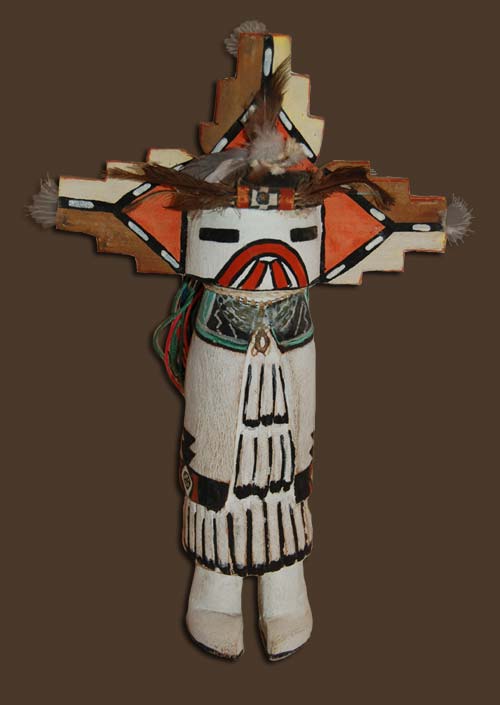 The Salakomana is the female version and the Salakotaka is the male version of the Hopi Pueblo pair of katsinas. The Salakomana is distinguishable by her white face and white moccasins. The two always appear as a pair. The basic intent of the Salako Ceremony is, of course, to bring the clouds from which will come the rain.
The Salakomana is the female version and the Salakotaka is the male version of the Hopi Pueblo pair of katsinas. The Salakomana is distinguishable by her white face and white moccasins. The two always appear as a pair. The basic intent of the Salako Ceremony is, of course, to bring the clouds from which will come the rain.
This carving is from cottonwood root and is a single-piece carving except for the addition of the three-piece tablita and the piece of wood on the forehead from which feathers protrude. Multi-colored embroidery thread falls from a bundle of feathers on the back of the mask. The feathers on the front and around the hem are carved into the wood and highlighted with black paint. The painted design on the neck and hem of the manta reproduce the embroidered design on a woman's manta.
Hopi Pueblo Traditional Salakomana Katsina Doll - 25040
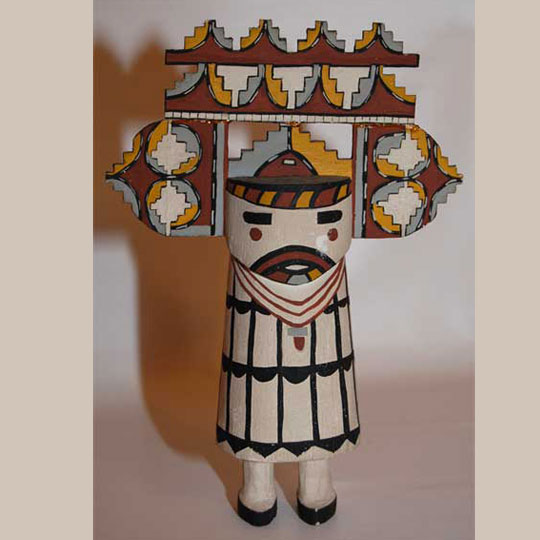 The Hopi Salako Ceremony is held infrequently and is therefore one of the least known of the Hopi Pueblo ceremonies. According to Barton Wright, the last known one on Third Mesa was held in 1912, and the last one on Second Mesa was held in 1972. I attended the ceremony at the village of Shungopavi on Second Mesa around 1985, but I do not recall the exact year. It was held following another ceremony and I was about ready to leave the plaza when this ceremony started. It was a most impressive ceremony.
The Hopi Salako Ceremony is held infrequently and is therefore one of the least known of the Hopi Pueblo ceremonies. According to Barton Wright, the last known one on Third Mesa was held in 1912, and the last one on Second Mesa was held in 1972. I attended the ceremony at the village of Shungopavi on Second Mesa around 1985, but I do not recall the exact year. It was held following another ceremony and I was about ready to leave the plaza when this ceremony started. It was a most impressive ceremony.
Cochiti Pueblo Female Buffalo Dancer Painting by Joe Hilario Herrera - C3808D
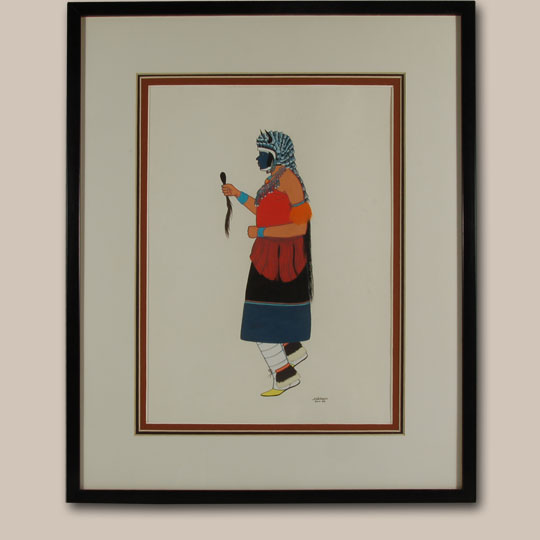 Joe Hilario Herrera was born at Cochiti Pueblo, the son of Tonita Peña, who was originally from San Ildefonso, but moved to Cochiti after the death of her mother. She was raised by an aunt and uncle. Although she lived at Cochiti all of her adult life, she is still known as a San Ildefonso artist. Her son, Joe, however is recognized as a Cochiti Pueblo artist. Joe grew up watching his famous mother paint on an almost daily basis. His early art education was home schooled.
Joe Hilario Herrera was born at Cochiti Pueblo, the son of Tonita Peña, who was originally from San Ildefonso, but moved to Cochiti after the death of her mother. She was raised by an aunt and uncle. Although she lived at Cochiti all of her adult life, she is still known as a San Ildefonso artist. Her son, Joe, however is recognized as a Cochiti Pueblo artist. Joe grew up watching his famous mother paint on an almost daily basis. His early art education was home schooled.
Herrera attended the Santa Fe Indian School and continued on to achieve a Bachelor of Arts and a Masters of Arts in Education, both from the University of New Mexico. He continued his education in Puerto Rico, studying briefly under Raymond Jonson.
Kneeling Mudhead with Drum Katsina Doll from Zuni Pueblo - 25879
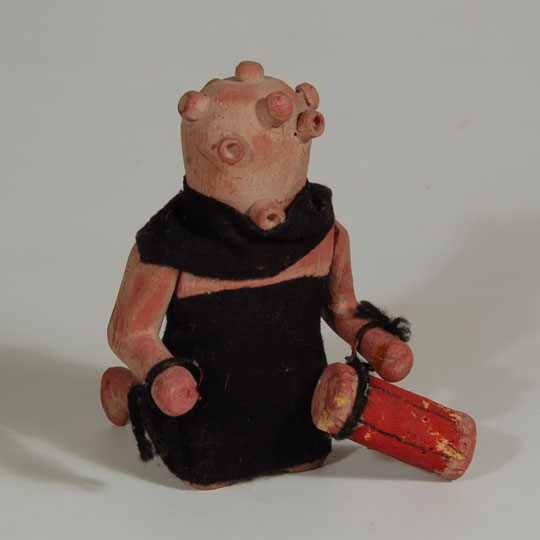 Although the Koyemshi (Mudheads) are childlike, or witless in their behavior, they are regarded as the "sages of the ancients, oracles who speak with the voices of idiots mixing wisdom and nonsense in every utterance. They are considered the fathers of the Zuni people and no other group is more sacrosanct or dangerous than the Koyemshi. To deny them anything, even in one's heart or mind, is to court disaster." They are major participants in the Zuni Shalako ceremony and are the first to appear for the event, arriving eight days before the ceremony. Wright, 1985
Although the Koyemshi (Mudheads) are childlike, or witless in their behavior, they are regarded as the "sages of the ancients, oracles who speak with the voices of idiots mixing wisdom and nonsense in every utterance. They are considered the fathers of the Zuni people and no other group is more sacrosanct or dangerous than the Koyemshi. To deny them anything, even in one's heart or mind, is to court disaster." They are major participants in the Zuni Shalako ceremony and are the first to appear for the event, arriving eight days before the ceremony. Wright, 1985
Historic San Juan Pueblo Stone Polished Black Child’s Water Jar - C3642E
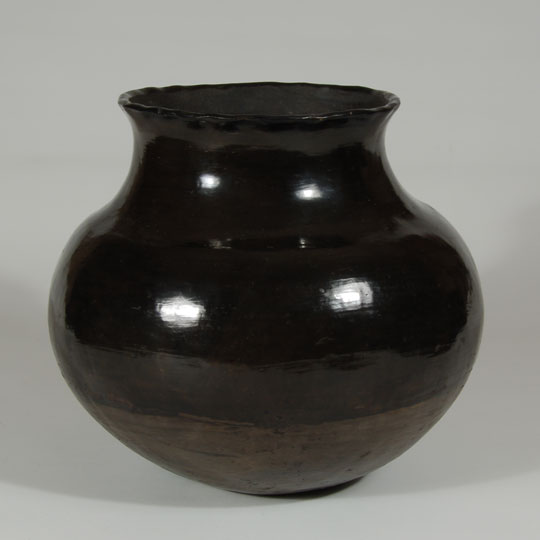 For those who like small vessels, this is a must! This is one of the nicest small San Juan Pueblo polished black ollas on the market. Its shape is faithfully reproduced from a large jar down to this size, a size frequently called a Child's Water Jar. It is the traditional San Juan style with a polished black upper body and polished gray underbody, which has been made for centuries. In these jars, the red slip is wiped over the upper 2/3rd of the vessel body and the lower 1/3rd left without slip. Both upper and lower portions are then stone polished. When reduction fired, the red changes to black and the tan underbody changes to gray. A very fine fluted or wavy rim serves as the vessel's only deviation from a plain surface. The interior of the neck is matte finish. It probably dates to circa 1900-1930 period.
For those who like small vessels, this is a must! This is one of the nicest small San Juan Pueblo polished black ollas on the market. Its shape is faithfully reproduced from a large jar down to this size, a size frequently called a Child's Water Jar. It is the traditional San Juan style with a polished black upper body and polished gray underbody, which has been made for centuries. In these jars, the red slip is wiped over the upper 2/3rd of the vessel body and the lower 1/3rd left without slip. Both upper and lower portions are then stone polished. When reduction fired, the red changes to black and the tan underbody changes to gray. A very fine fluted or wavy rim serves as the vessel's only deviation from a plain surface. The interior of the neck is matte finish. It probably dates to circa 1900-1930 period.
Large Hopi Pueblo Hemis Katsina Doll - 25878
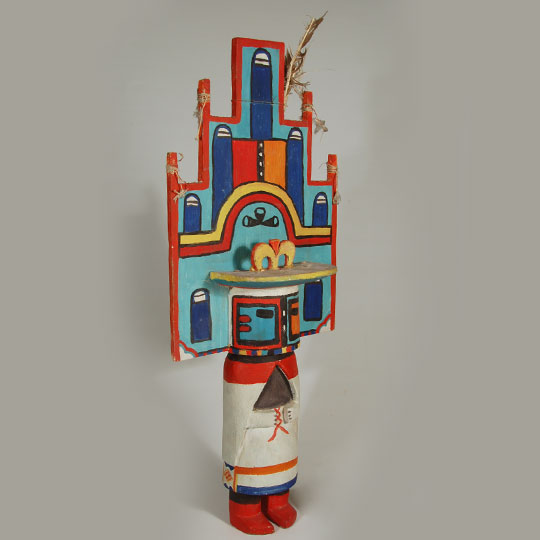 The Hopi live in a desert and rely solely on rain for their crops and animals. It is to the Katsinas that the Hopi plea for rain. In exchange for rain from the Katsinas, the Hopi present them with pahos (prayer feathers). They do not ask for anything from the katsinas without giving something in return.
The Hopi live in a desert and rely solely on rain for their crops and animals. It is to the Katsinas that the Hopi plea for rain. In exchange for rain from the Katsinas, the Hopi present them with pahos (prayer feathers). They do not ask for anything from the katsinas without giving something in return.
Although the Hemis Katsina may appear in any Katsina dance, they are best known for their participation in the Niman Ceremony, a ceremony where a large number of Hemis and Hemismana are the only katsinas represented. The Hemis Katsina is most frequently selected for the Niman because he is a beautiful impersonation and his songs are popular with the Hopi.
Painting of Mythological Avanyu and a Pair of Skunks by Julián Martinez - C3808B
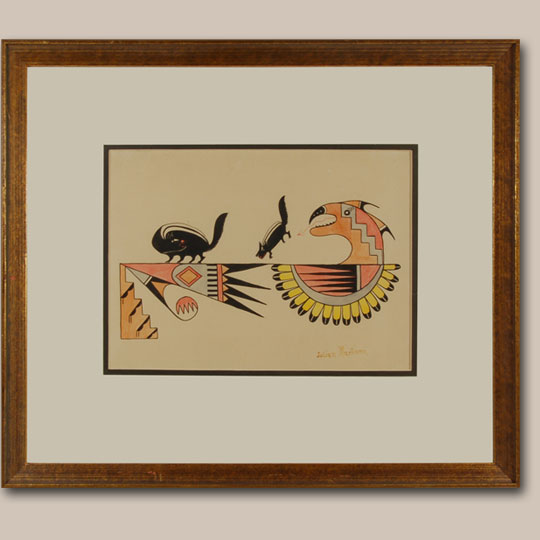 Several of the early San Ildefonso Pueblo artists often painted wildlife and barnyard animals. Skunks seem to have been a favorite. It is a matter of conjecture as to whether Julian Martinez or Awa Tsireh is responsible for the advent of the skunk in Pueblo painting, but Julian used this highly decorative animal most delightfully in many compositions, thereby establishing it as a fully respectable subject in Pueblo art. The mythological Avanyu (water serpent) is another image favored by San Ildefonso and Santa Clara artists. Julian used it many times on black pottery.
Several of the early San Ildefonso Pueblo artists often painted wildlife and barnyard animals. Skunks seem to have been a favorite. It is a matter of conjecture as to whether Julian Martinez or Awa Tsireh is responsible for the advent of the skunk in Pueblo painting, but Julian used this highly decorative animal most delightfully in many compositions, thereby establishing it as a fully respectable subject in Pueblo art. The mythological Avanyu (water serpent) is another image favored by San Ildefonso and Santa Clara artists. Julian used it many times on black pottery.
Santa Clara Pueblo Large Bear Paw Jar by LuAnn Tafoya - C3260D
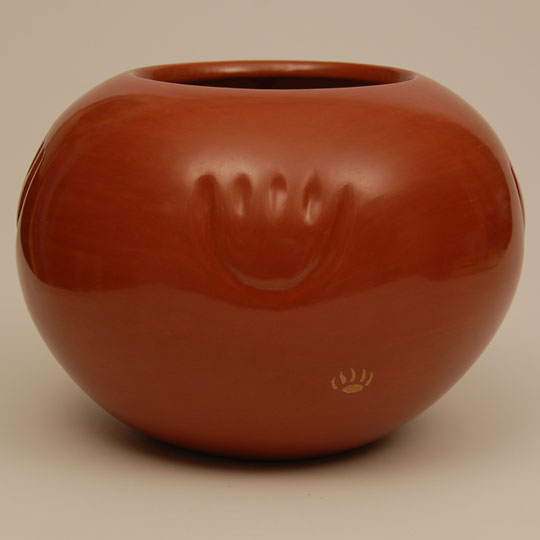 Lu Ann Tafoya, a daughter of Margaret Tafoya, certainly inherited the talent to produce beautifully sculpted jars with outrageously burnished surfaces. She has made jars almost three feet tall, a feat not easily accomplished. This globular-shaped jar has a beautiful deep red slip that was burnished to a high luster. There are four bear paw designs around the circumference.
Lu Ann Tafoya, a daughter of Margaret Tafoya, certainly inherited the talent to produce beautifully sculpted jars with outrageously burnished surfaces. She has made jars almost three feet tall, a feat not easily accomplished. This globular-shaped jar has a beautiful deep red slip that was burnished to a high luster. There are four bear paw designs around the circumference.
Kewa - Santo Domingo Pueblo Mosaic Turquoise Earrings - 25784
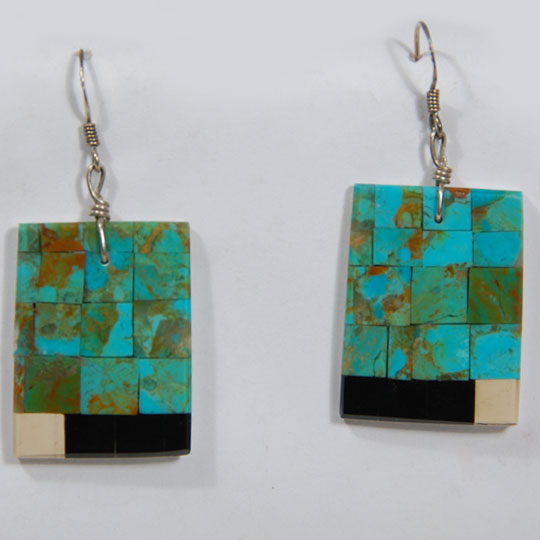 Santo Domingo artisans are adept at working with materials such as shell, turquoise, jet and others in fashioning jewelry whereas Navajo artisans work more with silver. This pair of earrings consists predominately of squares of beautiful blue turquoise mounted in mosaic style on a flat shell backing. The earrings are equipped for pierced ears.
Santo Domingo artisans are adept at working with materials such as shell, turquoise, jet and others in fashioning jewelry whereas Navajo artisans work more with silver. This pair of earrings consists predominately of squares of beautiful blue turquoise mounted in mosaic style on a flat shell backing. The earrings are equipped for pierced ears.
Kewa - Santo Domingo Pueblo Mosaic Multi-stone Earrings - 25783
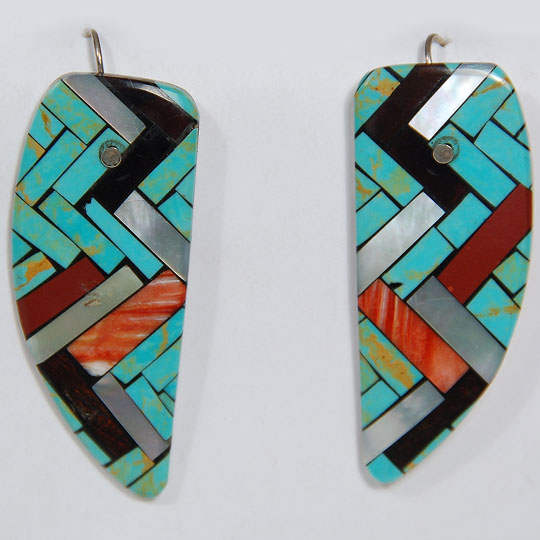 These Southwest Indian Jewelry earrings from Santo Domingo are comprised of rectangular cut stones arranged in a herringbone pattern over shell backing. They are equipped for pierced ears. There is no artist name. The arrangement of the colors of the stones provides for a beautiful palette.
These Southwest Indian Jewelry earrings from Santo Domingo are comprised of rectangular cut stones arranged in a herringbone pattern over shell backing. They are equipped for pierced ears. There is no artist name. The arrangement of the colors of the stones provides for a beautiful palette.
Navajo Nation Sterling Silver and Turquoise Bracelet - 25782
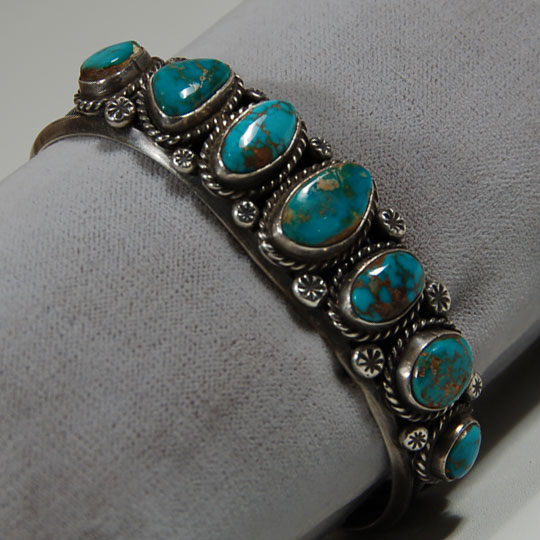 This exquisite mid-20th century Navajo-made bracelet has seven beautiful ocean-blue turquoise cabochons, each mounted in silver bezels on top of the three-wire shank. The outer two bars of the shank are triangular shaped silver and the middle one is twisted wire rope. Each bezel is wrapped in twisted wire rope and each cab is separated by a pair of silver drops. Each end of the bracelet is reinforced with a silver plate.
This exquisite mid-20th century Navajo-made bracelet has seven beautiful ocean-blue turquoise cabochons, each mounted in silver bezels on top of the three-wire shank. The outer two bars of the shank are triangular shaped silver and the middle one is twisted wire rope. Each bezel is wrapped in twisted wire rope and each cab is separated by a pair of silver drops. Each end of the bracelet is reinforced with a silver plate.
Cochiti Pueblo Female Storyteller holding a Child in her Blanket - C3688.53
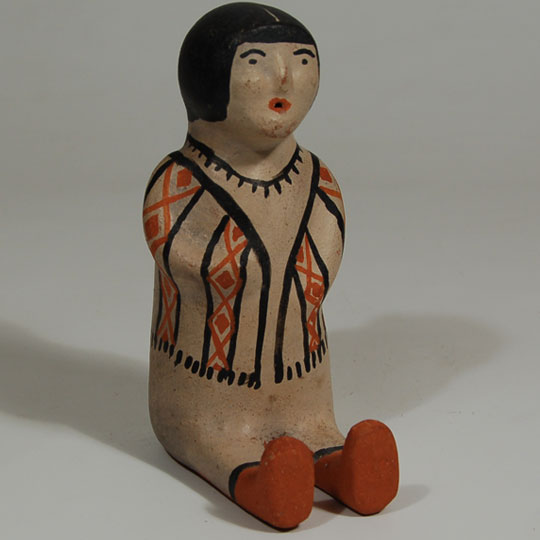 It is not unusual for pueblo potters to forego signing their work, especially some of the older women, as it is not an accepted practice to seek fame above others. Many older potters adhere to this philosophy. Whether that is the reason we see unsigned contemporary pottery is not really known but perhaps it carries some weight.
It is not unusual for pueblo potters to forego signing their work, especially some of the older women, as it is not an accepted practice to seek fame above others. Many older potters adhere to this philosophy. Whether that is the reason we see unsigned contemporary pottery is not really known but perhaps it carries some weight.
Pair of Kewa (Santo Domingo) Pueblo Chile Bowls - C3753.10-19
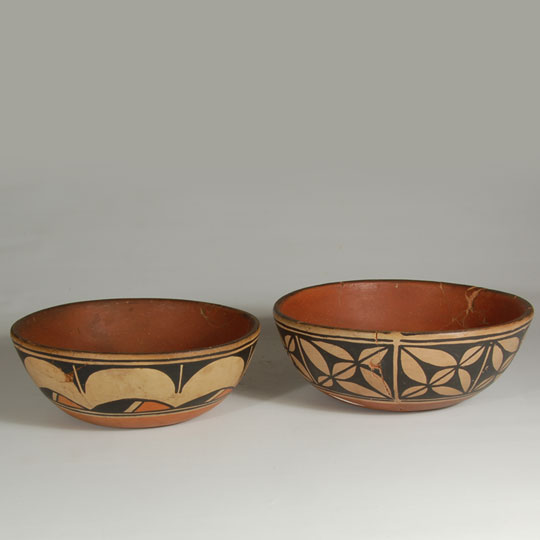 These two chile bowls have been broken and repaired. We have chosen to post them together and sell them as a pair for a total of $150. These are part of a large collection of pottery we received from our client who recently moved from Santa Fe. We would not normally accept pottery in this condition but these were part of a large collection so we accepted them as a favor to our client. Although they have no significant monetary value, they do have a nice visual appeal and will serve well for someone wishing to display something similar with a modest investment.
These two chile bowls have been broken and repaired. We have chosen to post them together and sell them as a pair for a total of $150. These are part of a large collection of pottery we received from our client who recently moved from Santa Fe. We would not normally accept pottery in this condition but these were part of a large collection so we accepted them as a favor to our client. Although they have no significant monetary value, they do have a nice visual appeal and will serve well for someone wishing to display something similar with a modest investment.
Historic Zia Pueblo Olla with Birds and Rainbows - C3753.67
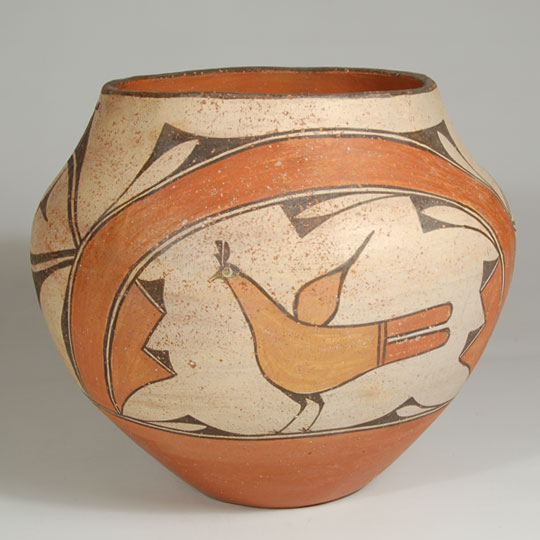 Realistic birds on Zia pottery appeared around 1820 and their use has continued to today. They became much more in evidence by 1870. The birds on this jar are typical of Zia birds of the early 20th century. The birds each have a wing that point upward from the body that looks similar to a leaf. The birds have short legs, red bodies outlined in black, split tail feathers and black heads. The pupil is a small dot in a round eye and the beak is split as if the mouth is partially open. The lobes on the head that appear to be ears actually represent feathers.
Realistic birds on Zia pottery appeared around 1820 and their use has continued to today. They became much more in evidence by 1870. The birds on this jar are typical of Zia birds of the early 20th century. The birds each have a wing that point upward from the body that looks similar to a leaf. The birds have short legs, red bodies outlined in black, split tail feathers and black heads. The pupil is a small dot in a round eye and the beak is split as if the mouth is partially open. The lobes on the head that appear to be ears actually represent feathers.
Comanche Dancer with Avanyu Painting by Romando Vigil (Tse Ye Mu) - C3808C
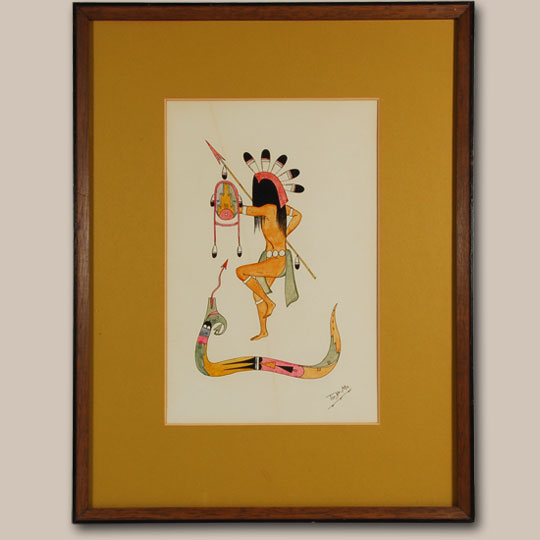 Romando Vigil was one of the San Ildefonso self-taught artists in the early part of the 20th century. He was a leader within the San Ildefonso Watercolor Movement, a movement that caught fire during 1915 to 1917. It fostered an art form unmatched in the culture history of the world. These men portrayed tribal culture and local wildlife, attaining a flat decorative character, absent of backgrounds and foregrounds, and free of traditional perspective, with an unerring color sense. Their success in these presentations was due to their understanding the ceremonials they painted because they had participated in them since childhood. They understood the meanings of the symbolism they interpreted.
Romando Vigil was one of the San Ildefonso self-taught artists in the early part of the 20th century. He was a leader within the San Ildefonso Watercolor Movement, a movement that caught fire during 1915 to 1917. It fostered an art form unmatched in the culture history of the world. These men portrayed tribal culture and local wildlife, attaining a flat decorative character, absent of backgrounds and foregrounds, and free of traditional perspective, with an unerring color sense. Their success in these presentations was due to their understanding the ceremonials they painted because they had participated in them since childhood. They understood the meanings of the symbolism they interpreted.
Original Painting of an Antelope by Teeyacheena (Rafael Medina) - C3808A
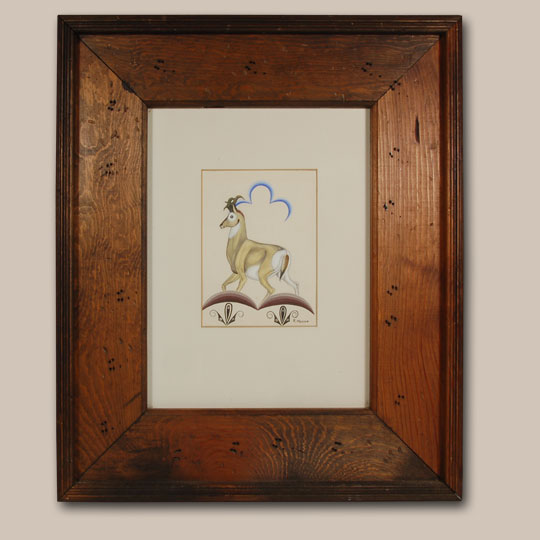 Clara Lee Tanner, in her book Southwest Indian Painting, stated that Rafael Medina studied at Albuquerque under Velino Herrera (Ma Pe Wi) and José Rey Toledo. She does not state that he attended the Albuquerque Indian School but perhaps that is where he studied before entering the Santa Fe Indian School. Neither Dunn nor Tanner is clear about that. Medina attended the Santa Fe Indian School after the departure of Dorothy Dunn and during the tenure of art teacher Gerónima Montoya, probably entering school in the early 1940s. Following high school, he attended the Institute of American Indian Arts (IAIA) in Santa Fe.
Clara Lee Tanner, in her book Southwest Indian Painting, stated that Rafael Medina studied at Albuquerque under Velino Herrera (Ma Pe Wi) and José Rey Toledo. She does not state that he attended the Albuquerque Indian School but perhaps that is where he studied before entering the Santa Fe Indian School. Neither Dunn nor Tanner is clear about that. Medina attended the Santa Fe Indian School after the departure of Dorothy Dunn and during the tenure of art teacher Gerónima Montoya, probably entering school in the early 1940s. Following high school, he attended the Institute of American Indian Arts (IAIA) in Santa Fe.
Original Painting of Sixteen Mystical Horses by Pop Chalee - C3811
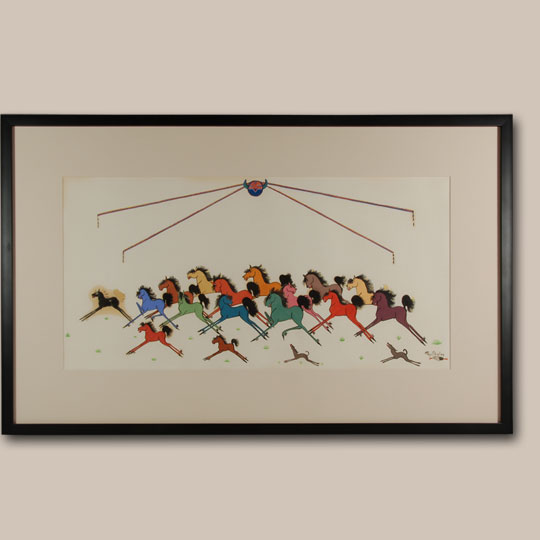 Merina Lujan began life in a mining town in Utah. As a child she spent her summers at Taos Pueblo, her father's home, where she became acquainted with Mabel Dodge Luhan who was married to her uncle Tony Luhan. She also spent time in the village of Taos where she befriended the Taos artist community, many of whom indulged the pretty young girl by allowing her to watch them paint.
Merina Lujan began life in a mining town in Utah. As a child she spent her summers at Taos Pueblo, her father's home, where she became acquainted with Mabel Dodge Luhan who was married to her uncle Tony Luhan. She also spent time in the village of Taos where she befriended the Taos artist community, many of whom indulged the pretty young girl by allowing her to watch them paint.
She attended the Santa Fe Indian School. As a student of Dorothy Dunn she perfected her style in which Dunn described her as "...a specialist in minutely decorative woodland scenes of delicacy and sprightliness. Her small alert animals played against a colorful, balanced pattern of leaves, stems, and flowers, as bright-feathered birds darted in and out among treetops."

